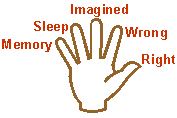|
|
||||||
|
|
Online Courses from Swami Jnaneshvara and Abhyasa Ashram
Yoga
Sutras 1.5-1.11:
|
|||||
 |
|
|
To position
the five kinds of thoughts on the fingers |
|
Witnessing the five kinds of thoughts: By learning to observe the thinking process, and then to discriminate between these five types of mental objects, we start to gain a mastery over them, and their ability to control our actions, speech, and thoughts.
With mastery of witnessing: As that mastery comes within reach, we gradually find a neutral, non-attached (1.15, 3.38) stance of witnessing, where we can observe the entire flow of mind, while remaining peacefully undisturbed, unaffected, and uninvolved. Meditation can systematically deepen.
Without mastery of witnessing: Without that mastery, we become victims to our own unconscious mental process, losing free choice in external life as well as the ability to experience deep meditation.
Pramana is the one to cultivate: Of the five kinds of thought patterns, pramana, or correct knowledge is the one to cultivate. The process of continually seeing ever more clearly brings progress on the path of meditation. This process of seeing clearly, of seeing things as they are, is one of the ways of describing the inner journey, eventually revealing that absolute, unchanging True Self.
1.7
Of these five, there are three ways of gaining correct knowledge
(pramana): 1) perception, 2) inference, and 3) testimony or verbal
communication from others who have knowledge.
(pratyaksha anumana agamah pramanani)
- pratyaksha = direct perception or cognition
- anumana = inference, reasoning, deduction
- agamah = authority, testimony, validation, competent evidence
- pramanani = valid means of knowing, proofs, sources of correct knowing
Three ways to attain correct knowing: The first of the five kinds of thought patterns described in the last sutra is pramana, which is real or valid cognition, right knowledge, valid proof, seeing clearly. Here, in sutra 1.7, three different ways are described about how one acquires that correct knowing. These are direct perception, reasoning, and validation. Each of them are valid, and standing alone can provide correct knowing, though you want the three to be in agreement. This description of correct knowing applies both to mundane ways of knowing, such as seeing objects in the external world, and to spiritual insights on the inner journey.
Seek experience, not mere belief: In the oral Yoga tradition, it is said that you should not believe what you hear, but should seek direct experience. This is the meaning of the first of these three ways of knowing. The second part is that of reasoning, whereby you want that experience to be understood in the light of your own inference or reasoning. The third part is that you seek the validation through some respected authority or testimony. This might be a textual authority, such as the Yoga Sutras, or some respected person who has first hand knowledge.
Getting these three to converge: When you can get these three to converge, meaning that experience, reasoning, and authoritative validation all agree with one another, then you know, and you know that you know, in regard to any particular aspect of the inner journey. Thus, this sutra is an extremely practical tool for the inner journey.
What if the three have not converged?: Consider the alternatives of these three converging. Often, people will have some experience with their spiritual journey, and have no understanding of what has happened, nor any validation. This can be frustrating and fearful, and can leave one wandering, feeling lost for a very long time. If the experience were understood and validated, it could be integrated and used as a stepping stone to more advanced spiritual insights. If one has only logical reasoning, but no experience or validation, it can lead to mere intellectualizing. If one only has the authoritative knowledge, without personal understanding or experience, it can lead to cold memorization, such as can happen in academia or blind faith religion.
Seek each, and also convergence: For the sincere seeker, direct experience, reasoning, and validation are all three sought in relation to the inner journey, and in such a way that there is a convergence of the three.
1.8
Incorrect knowledge or illusion (viparyaya) is false knowledge formed by
perceiving a thing as being other than what it really is.
(viparyayah mithya jnanam atad rupa pratistham)
- viparyayah = unreal cognition, indiscrimination, perverse cognition, wrong knowledge, misconception, incorrect knowing, not seeing clearly
- mithya = of the unreal, of the false, erroneous, illusory
- jnanam = knowing, knowledge
- atad = not its own, not that
- rupa = form, nature, appearance
- pratistham = based on, possessing, established, occupying, steadfast, standing
Incorrect knowing: Perceiving a thing as being other than what it really is.
 Classic
examples: A classic example of the shifting perception is the Rubin
Vase, which is both a picture of a vase and a picture of two faces at the
same time. Two classic examples are given by the Yogis for the misperception
called viparyaya. First is the mistaking of a rope for a snake when the
light is low, such as the twilight hours between day and night. The rope is
always a rope, although the mind misperceives it in the moment. The second
is similar, and is mistaking a post in the distance as being a man standing
in the shadows.
Classic
examples: A classic example of the shifting perception is the Rubin
Vase, which is both a picture of a vase and a picture of two faces at the
same time. Two classic examples are given by the Yogis for the misperception
called viparyaya. First is the mistaking of a rope for a snake when the
light is low, such as the twilight hours between day and night. The rope is
always a rope, although the mind misperceives it in the moment. The second
is similar, and is mistaking a post in the distance as being a man standing
in the shadows.
Clearing many levels of misperception: During the inner journey of Yoga meditation, there are many currents and crosscurrents that are explored and examined (2.1-2.9, 2.10-2.11, 3.9-3.16, 4.9-4.12). One way of describing this process is that we are trying to see where we have made mistakes in perception (viparyaya), and are trying to see clearly (pramana, 1.7). Then we can transcend that object in the mind field, getting past the four forms of ignorance, or avidya (2.5), and experiencing our true Self (1.3).
Observe the misperceptions of daily life: If the reason we are not experiencing our true nature (1.3) is the clouding of false identities (1.4), then we want to become adept at noticing the ways in which we are not seeing clearly, so as to correct the misperceptions. For most of us, this process of mistaken identity is easily done in daily life.
Relationships with people: Recall how often you see some situation or person to be one way, only to later discover that there was some missing piece of information that changes your perception completely. For example, imagine you see a friend or co-worker who has a scowl rather than a smile, and whose attitude might seem negative towards you. That person may actually be angry from having had an argument with a family member, and the reaction had nothing to do with you.
Misperceptions can cause colorings: The problem with these misperceptions is that they can lead to the colorings, kleshas (1.5, 2.1-2.9). If they were simply misperceptions with no coloring, there would be no problem. But imagine the potential of the misperceptions of relationships with people, as in the example above. The result might be increased egoism, attractions, aversions, or fears. Thus, we want our misperceptions (viparyaya) to become correct perceptions (pramana, 1.7).
1.9
Fantasy or imagination (vikalpa) is a thought pattern that has verbal
expression and knowledge, but for which there is no such object or reality
in existence.
(shabda jnana anupati vastu shunyah vikalpah)
- shabda = word, sound, verbal expression
- jnana = by knowledge, knowing
- anupati = following, in sequence, depending upon
- vastu = a reality, real object, existent
- shunyah = devoid, without, empty
- vikalpah = imagination, verbal misconception or delusion, fantasy, hallucination
There is no perceptible reality: Our minds are often thinking and creating chains of words and images. Often this process leads to thoughts or impressions that have no actual reality. The two kinds of thoughts discussed in the past two sutras both related to realities, whether seen clearly (1.7) or not clearly (1.8). However, vikalpa has no such corresponding reality, whether seen clearly or not.
Classic example: A classic example that the Yogis use is that of the horns of a rabbit. A rabbit does not have horns, although it can easily be conceptualized. The thought and the image are there, but there is no corresponding reality.
With objects and people: It seems to be a habit of the human mind to form all sorts of fantasy ideas in relation to objects and people. I might fantasize having this or that object, doing or saying something with some person, or creating in my mind field both the objects and the people. For example, with the real objects and people in my world, I might even create the fantasy idea that these are mine. The mental impressions of the objects and people might be real (1.7) or misperceived (1.8), but the impressions related to the concept mine are complete fantasy, or vikalpa.
Living in the future: Often we speak of a thought process, which is one of living in the future. The mind is really taking the current thoughts, rearranging them this or that way, and then fantasizing some new combination as being the future, even though that fantasy is occurring in the present moment.
Vikalpa and avidya: It is useful to reflect on the relationship between this fantasy process of mind and the four forms of ignorance (avidya) that are described in sutra 2.5.
Creativity: While we are talking about how to deal with the thought patterns of the mind (1.2) so as to attain Self-realization (1.3), it is important to note that these mental processes are not bad in the context of life and the world. The same fantasy or vikalpa that clouds over our true Self is also the creative mind that finds solutions to problems in the external world or at our personality level of being. It is even the vikalpa that creates the helpful lifestyle and environment in which we live so as to be able to do our meditations.
The subtler examples: Eventually, as meditation deepens, we come to see ever more clearly that virtually our whole perception of external and internal reality is vikalpa, a product of imagination. Notice that even the root of the word imagination is image; countless images are produced, stored, and then arise. Even the subtleties of the five elements (earth, water, fire, air, space), the cognitive and active senses (indriyas), and the four functions of mind are products of this process of vikalpa. This is the process of subtle discrimination in the later sutras.
1.10
Dreamless sleep (nidra) is the subtle thought pattern which has as its
object an inertia, blankness, absence, or negation of the other thought
patterns (vrittis).
(abhava pratyaya alambana vritti nidra)
- abhava = absence, non-existence, non-occurrence, negation, voidness, nothingness
- pratyaya = the cause, the feeling, causal or cognitive principle, notion, content of mind, presented idea, cognition
- alambana = support, substratum, leaning on, dependent on, having as a base or foundation
- vritti = operations, activities, fluctuations, modifications, changes, or various forms of the mind-field
- nidra = deep sleep
Mind focuses on the object called sleep: It is as if sleep is a process whereby the mind is focusing on absence itself, as if that non-existence were an object itself. Metaphorically, it is as if the mind is focused on a black, fuzzy object that is set against a black field. There is something there for the mind to be focused on, yet, in the sense of what we normally consider to be an object, there is nothing there.
Mind typically rests on a support: Normally the mind rests, or focuses on some object. This is the meaning of the word alambana. Thus, nidra, or sleep, is the state where attention is focused on, or absorbed in that object of negation or voidness itself.
Sleep is the absence of the other four: When any one of the other types of thought patterns is present, the mind is usually engaged or entangled in those images. When all four of them subside, or when the mind is not involved in them, there comes the state of sleep. Alternatively, when one is free from all five of them, and remains conscious, that is samadhi.
Sleep is actually an object: This might, at first glance, seem to be an insignificant point, but it is actually rather important. Remember the principle in the first few sutras (1.2-1.4) that the reason we do not experience the eternal Self, is that consciousness is entangled with other objects. When we see that entering sleep is a process of focusing on still one more object, it becomes clearer why we want to remain in the waking state for meditation, while learning to let go of the intervening objects, including sleep, which is like that black, fuzzy object. In meditation, we focus on one object, intentionally, so that at some point we can let go of all objects, and experience the objectless state beyond all of the objects.
In another sense, sleep is a level, not an object: When we translate these words of meditation science from Sanskrit to English, we can unintentionally end up with some confusion. Here, nidra is translated as sleep. However, in considering the levels of consciousness, the domains of gross, subtle, and causal, that deeper level is called prajna, which is a level of supreme (pra) knowledge (jna). This too is considered to be the level of deep sleep. Thus, we are using the word sleep in two compatible, though different ways. If you know this, there is no confusion. The Yoga of the Yoga Sutras is very practical, and here the emphasis is on contrasting the attention getting wrapped around this vritti (thought pattern) of sleep, as in contrast to the other four types of vrittis.
Mastering false identity with sleep: When we talk about mastering the mental process in relation to entanglement with objects or fantasies, it can make sense, even at a more surface level of understanding. In relation to sleep, it is important to note that we want to move towards disidentification even with that object, just like the others. Then, again, the true Self comes shining through.
Do not mistake sleep for samadhi: The higher samadhi is without any object that has form, which has sometimes been described as void. It is a big mistake to confuse that samadhi with the void of other objects that comes with deep sleep. These two are very different experiences.
1.11
Recollection or memory (smriti) is mental modification caused by the inner
reproducing of a previous impression of an object, but without adding any
other characteristics from other sources.
(anubhuta vishaya asampramoshah smritih)
- anubhuta = experienced
- vishaya = objects of experience, impressions
- asampramoshah = not being stolen, not being lost, not having addition
- smritih = memory, remembering
Memory can take on associations: Memory is something with which we are all familiar. Some previously stored impression simply awakens, stirs in the unconscious, and then springs forth into the conscious awareness, having pierced the veil between conscious and unconscious. However, a rising memory often brings along with it many other memories that then get linked in such a way that the original memory is not seen in its pure form. In other words, the memory is being distorted; it is commingled with the other types of thought patterns.
Mere memory is less of a block to meditation: The memory being described here is the pure memory, without having stolen, or had additions from other memories or the creative, fantasizing, hallucinating process of mind. It is quite natural for these thought impressions to rise in the mind field. By discriminating between the types of thoughts, we can see which are simply memories, and which are memories that have become distorted and effectively turned into fantasies, which are vikalpa, described in sutra 1.9. Mere memory is not so disturbing to our natural peace of mind, whereas when associated with all of the other inner process, leads to the troublesome mental process that blocks deep meditation.
------- This site is devoted to
presenting the ancient Self-Realization path of
the Tradition of the Himalayan masters in simple, understandable and
beneficial ways, while not compromising quality or depth. The goal of
our sadhana or practices is the highest
Joy that comes from the Realization in direct experience of the
center of consciousness, the Self, the Atman or Purusha, which is
one and the same with the Absolute Reality.
This Self-Realization comes through Yoga meditation of the Yoga
Sutras, the contemplative insight of Advaita Vedanta, and the
intense devotion of Samaya Sri Vidya Tantra, the three of which
complement one another like fingers on a hand.
We employ the classical approaches of Raja, Jnana, Karma, and Bhakti
Yoga, as well as Hatha, Kriya, Kundalini, Laya, Mantra, Nada, Siddha,
and Tantra Yoga. Meditation, contemplation, mantra and prayer
finally converge into a unified force directed towards the final
stage, piercing the pearl of wisdom called bindu, leading to the
Absolute.



